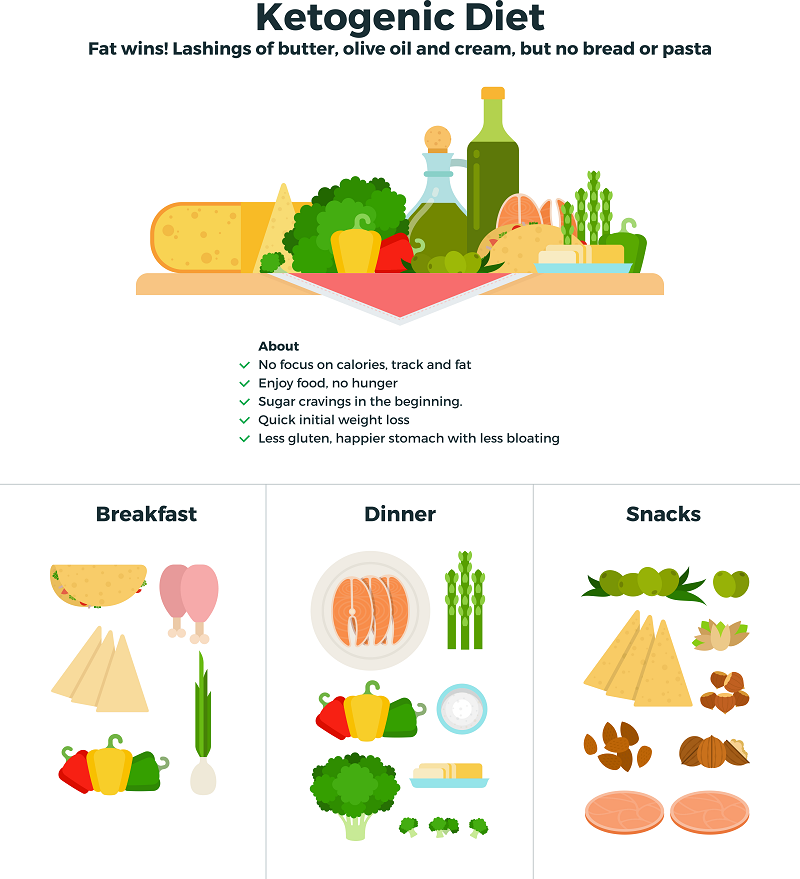Fat : It’s what’s for dinner – The Ketogenic Diet


The ketogenic diet has been getting more and more press in recent years. It seems that everyone is touting the benefits of this ‘new-found’ style of eating.
It seems that everyone from weight lifters and weight losers, biohackers and health optimists, cancer and seizure patients are all-in. Nevertheless, questions continue to swirl: What is the ketogenic diet, anyway? Is it just another fad? Is it safe long term? Is it safe at all? Well, you’ve come to the perfect place to dive into the answers.
Ketosis 101
The ketogenic diet is a way of eating that intentionally puts your body into a state of ketosis. Ketosis is a metabolic state that occurs with either very low caloric intake (i.e. the starvation response) and/or very low carbohydrate intake. The body’s preferential fuel source is glucose: the simplest form of carbohydrate, or sugar (glucose and blood sugar may be used interchangeably). When glucose is restricted, the liver will begin utilizing fatty acids from your stored body fat and ingested dietary fat to produce ketone bodies. This is because from an evolutionary point of view, ketosis was designed to keep the brain active and alert and maintain sufficient energy levels for survival (including energy-demanding activities such as hunting and migrating), ketone bodies are a highly dense, clean burning form of energy, which is where many of the ketogenic diet’s purported health benefits arise.
It is important to note the difference between nutritional ketosis and diabetic ketoacidosis. The first one is a health-enriching state; the second is life-threatening. In diabetic ketoacidosis, which can occur in Type 1 diabetes or uncontrolled Type 2 diabetes, both ketone and glucose levels become high. Rather than the safe range of 1.5-3 mg/dL, ketones can climb to 10 mg/dL or higher in ketoacidosis. Because ketone bodies are acids (3 to be exact – beta-Hydroxybuterate, acetoacetate and acetone) and excessive glucose is acidic in the blood, the blood’s pH lowers outside of range (blood pH must stay between 7.35 and 7.45). This dangerous acidic state can result in confusion, seizures, and eventually death if not immediately addressed.
Ketognic Diet
The ketogenic diet involves intentionally putting your body into a state of nutritional ketosis by simultaneously significantly restricting carbohydrates, eating small to moderate amounts of protein (protein can be converted into glucose) and high amounts of fat. Because caloric reduction also initiates ketosis, combining this way of eating with intermittent fasting enhances the process. Though everyone’s tolerance is different, generally speaking, carbohydrate levels are reduced to approximately 20-30 grams of carbs per day, or roughly 5-10% of the diet. Protein accounts for roughly 10-15%, and the remainder belongs to fat. It is important to emphasize quality fat: Avocado, macadamia and Brazil nuts, coconut, grass-fed wild-caught animal products, butter or ghee, olive oil. This is NOT an excuse to go binge on potato chips (they have too many carbs anyway!).
The process of entering ketosis is different for everyone, too. Because the body is typically accustomed to utilizing glucose for fuel and therefore may lack some of the enzymes necessary to burn fatty acids and ketone bodies, the ‘transition’ period can be somewhat burdensome.
As far as duration goes, because ketosis is mimicking the starvation mechanism, it is not recommended to be a long-term sustained diet (i.e. longer than 3 months at a time). However, cycling in and out of ketosis (following for 4 weeks, eating normally for 4 weeks for example) is a way to continue to reap the benefits without adding too much stress to the body.
NOTE: It is critical to test ketone levels while undergoing a ketogenic diet to ensure ketosis is achieved. Simply restricting carbs and eating a high fat diet does not guarantee ketosis, and ketones generate the health benefits. Blood testing is preferred (You can buy an easy-to-use and inexpensive monitor called KetoMojo off of Amazon), though urine is the next best alternative.

Benefits of Nutritional Ketosis and a Ketogenic Diet
Research has identified that nutritional ketosis exerts positive benefits on a number of health conditions. Amongst other pathways, these benefits arise largely from its effectiveness at lowering insulin, repairing and regenerating mitochondria (the energy powerhouse of the cell), and facilitating healing processes within the cell.
Insulin
Upon consumption of dietary carbohydrates, insulin is the hormone responsible for shuttling glucose into the cell where it can be used for energy. However, today’s modern diet, typically rich in refined sugars, contributes to chronically elevated insulin levels as the cells become increasingly resistant to insulin, a condition known as insulin resistance, or pre-diabetes. If left unchecked, this eventually paves the way to Type 2 Diabetes.
Mitochondria
The mitochondria is best known for being the site where cellular energy is created. When they are clean and healthy, they are able to efficiently produce the body’s energy needs. However, accumulating oxidative stress from both the environment (pollution, poor diet, tap water, heavy metals, etc.) and from our own body (lack of antioxidants, stress, gut dysbiosis) can slowly lead to polluted and inefficient mitochondria (think of a city’s power plant starting to breakdown). Coupled with the role the mitochondria play in immune system signaling, more and more research is identifying a link between mitochondrial dysfunction and advanced aging, cancer, Alzheimer’s, heart disease, diabetes, and more. If that sounds familiar, that’s partly because hyperinsulinemia (high insulin) also contributes to mitochondrial breakdown, and vice versa.
In addition to the insulin-lowering effects, ketone bodies are not only a very clean burning fuel (produce less oxidative stress than glucose), they also operate an ancient cellular signaling pathway in the mitochondria – mTOR (mechanistic target of rapamycin). When not activated, the mTOR pathway is associated with cellular healing and repair. This promotes the recycling and regeneration of mitochondria, or essentially repairing and building new energy factories. When it is activated, mTOR becomes more anabolic, stimulating cellular growth. Neither is bad, as long as they stay in balance. However, when mTOR remains in an activated state, the cells never get a chance to undergo mitophagy and autophagy, mitochondrial regeneration and cellular regeneration, respectively. Glucose, protein, insulin, and other factors activate mTOR while fatty acids and ketone bodies do not. Therefore, the ketogenic diet (along with intermittent fasting which also inactivates mTOR) is an effective way of ‘cleaning out’ and repairing your cellular energy factories.
To Sum It Up
Nutrition will always be one of the most powerful healing agents. However, as with anything in health, there is never a one-size-fits-all approach. The ketogenic diet reminds us of how much of an impact food has on our health, but it is not a solution for everyone. There are many therapeutic diets, some of which may be more effective for different concerns and goals. Working with a professional is the best way to identify which one would be most therapeutic for you so that you can reach your optimal state of health.
Similar articles
-
Five Breakfast Foods That Sabotage Weight Loss
inStarting the day off with a low-sugar, high-protein breakfast will give you more sustained energy and boost your fat burning mechanisms. Indeed, these healthy breakfast foods will keep you feeling satisfied and jump-start weight loss!
-
The vitamin B complex family and you
inA vitamin is an organic compound that our body needs in small amounts for normal and effective metabolic functioning. Most vitamins are essential, as our body can’t make them itself, so we need to get them from our diet and preferably from a variety of foods.
-
Ensuring your child gets optimal nutrients (Part 1)
inEvery parent wants to ensure that their growing child receives the optimal amount of nutrients in their food. With the advent of Luncheables and Little Debbies though, this can become quite a challenge.
More in Nutrition
-
Shouldn’t I be losing weight on a plant-based diet?
inLots of people who have recently transitioned to a plant-based diet have been asking, “shouldn’t I be losing weight on a plant-based diet?”
-
Your health destiny is not your child’s health destiny
inAre you thinking about having kids, but have poor health yourself? Do you want to give your child a better health destiny than your own?
-
Gut-friendly muffins when you’re stuck at home
inGut-friendly muffins can be just the thing to bake when you’re stuck at home during these difficult times.

















